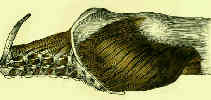- Anatomy:
- origin: posterior gluteal line of the ilium, tendon of sacrospinalis,
- dorsal surface of sacrum, coccyx and sacrotuberous ligament;
- insertion: gluteal tuberosity of femur and iliotibial tract of fascia lata
- it inserts partly into the iliotibial band and partly into the gluteal tuberosity of the femur;
- also inserting into the band, but further anteriorly is the tensor fascia lata;
- together, the gluteus maximus, the fascia lata (which covers the gluteus medius), and the tensor fascia latae form a continuous fibromuscular sheath, the outer layer of the hip musculature;
- action:
- extends thigh at the hip, assists in laterally rotating the thigh;
- upper and middle third section of the muscle are abductors and the lower 1/3 is inactive as an abductor or adductor in the standing position;
- reversed origin insertion action:
- when leg is fixed as in standing the gluteus maximus is an extensor of the pelvis on the thigh;
- nerve supply: inferior gluteal, S1 > L4, L5, S2; (see innervation of the lower extremity)
- Posterolateral Approach to the Hip:
- internal rotation of the hip may be facilitated by transversely sectioning several cm of the insertion of the gluteus maximus tendon on the femur;
- do this w/ hip maximally internally rotated, & place tip of hemostat under tendinious structure to lift it away from underlying vessels
- section only the amount of the tendon necessary to allows sufficient internal rotation to dislocate the hip;
- when performing this, the surgeon will often encounter bleeding from cruciate anastomosis vessels
- Gait:
- gluteus maximus contracts at heel-strike, slowing forward motion of trunk by arresting flexion of the hip and initiating extension;
- when gluteus maximus is weak, trunk lurches backward (maximus lurch) at heel-strike on weakened side to interrupt forward motion of trunk;
- during normal walking, hip extension is primarily a function of hamstrings rather than gluteus maximus
Contracture of the hip secondary to fibrosis of the gluteus maximus muscle. Gluteal fibrosis.
Gluteal compartment and crush syndromes. Report of three cases and review of the literature.
Surgical Technique: Endoscopic Gluteus Maximus Tendon Release for External Snapping Hip Syndrome.



